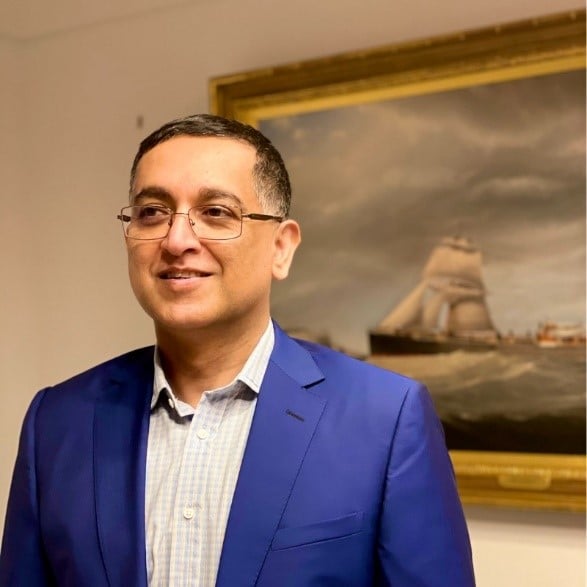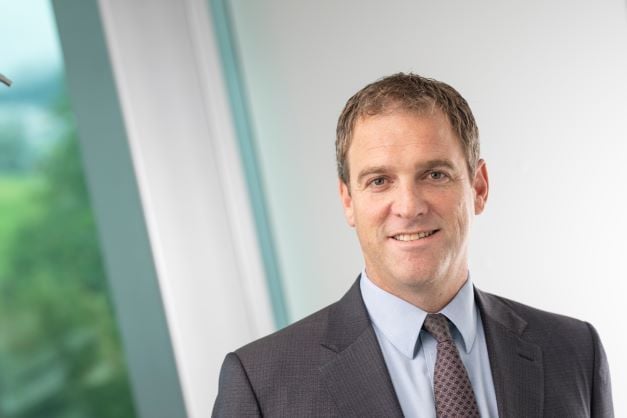Pankaj Khanna: Staying nimble amid growth and change
Since acquiring former tanker pool specialist Heidmar from TMS Group in November 2020, CEO Pankaj Khanna has grown the company’s commercial management business from six to nearly 60 vessels. He talks to ICS about what it takes to succeed and grow in an evolving shipping market.

How has Heidmar managed to grow its business since you bought it, especially through two very challenging years?
When we started, we had six ships and six people. The strengths that Heidmar has are recognition, relationships, transparency and people, so there were certain owners and charterers that provided us with a lot of support. But we were also more innovative in terms of what we were doing. In the past Heidmar mostly focused on pools. I changed the product more to commercial management.
We found that Ocean Tankers’ fleet had gone into liquidation, so we approached the liquidators and provided a solution to fund the reactivation of some of the ships, including paying for bunkers and repairing some ships. From that we gained almost 15 vessels, starting with crude tankers but then adding product tankers because we were doing a good job.
I have a long-standing relationship with Capital Group, and with Evangelos Marinakis in particular, and we combined in January 2022. We grew from six to 30 vessels by ourselves, and then with Capital that grew to about 55 to 60 managed vessels. So we’ve had quite a turnaround.
You’ve worked in large companies and helped develop several start-ups including Teekay Tankers, Alba Carriers, Ocean Rig and Pioneer Marine. What lessons do you take from those start-up experiences to operating established companies?
The problem with large corporates is that they can become elephants as far as decision making is concerned. There can be analysis paralysis with too many memos and meetings, then it takes like three months to take a decision. With a start-up, I take the decision, I move forward. I’m not saying that’s always right, but in this industry the opportunity window is very short and if you can’t take quick decisions, you lose the market.
So I think the lesson is to stay nimble. You need to make sure that your decision-making circle is small and that the process is quick, so you don’t lose your ability to move in the market.
Does that short window of opportunity make shipping difficult for finance and investors? Can we do more to make the industry attractive to them?
I think maritime is a very attractive sector, but you have to know what the sector is. Shipping is cyclical. We go through periods when the markets can be flat and, as in the last two years, periods when you’ll see the volatility. Financial institutions need to know which point of the cycle they’re getting in at and what to expect with that.
Some financial institutions lend when the markets are high. But if the cash flow is there it means that the asset values are also high, and when the cycle comes down you can end up in a situation where asset values have come down and then you start having loan-to-value and cash flow issues.
It’s similar for investors. There are some investors who have made a lot of money. But of course, you need to understand the cyclicality. If you think I will get in now, and I will get out in three to five years, that may not work out. It can. Let’s say you had bought ships in 2019 and 2020, in two to three years you could have doubled your money and made a lot on the cash flow side with the way the markets were. So it depends on timing.
Do you think that those cycles are changing with the turbulence we’ve seen in recent years?
The cycles have compressed. Twenty years ago, information was not available the way it is today. When an opportunity comes up in this market, it is available for a very short period before everybody knows about it. You know exactly what the orderbook is on a daily basis, and information is changing the demand side as well. Look at how quickly inflation hit us after COVID happened.
Another factor is that shipyards used to take two years to build a ship. Today they can turn the ship around in 12 months, maybe even in some cases in nine months. Then there has been a lot of attrition in yard capacity, especially in China but also in Korea and Japan. All these things have compressed the cycle.
How does decarbonisation come into those shipping cycles, and how do you make decisions on technology and fuels in this climate?
For decarbonisation, I don’t think that we can really make an informed determination on which solution is going to work out right away. I don’t like being the first mover on technology. I’ve seen over the years that first movers have never really made money, so I want to be the second mover. If I was advising someone, I would still go with the most economical design out there with conventional fuel, but go with all the other technologies, which are available to reduce emissions.
Look at what we did with scrubbers as an example. People asked whether it would be a successful investment or not. As it happens today, all the people who invested in scrubbers have recovered their investment in two to three years and are making crazy amounts of money.
Where I see the market going is towards carbon capture and storage (CCS). The infrastructure for conventional CCS already exists and we can develop scrubbers to capture carbon, keep it on board until your next port and then discharge the liquid CO2. The technology exists, but it’s not commercial enough to be put on board vessels at large scale. Once we get there. I think that’s the most feasible solution.
Do you see a role for vessel autonomy in managing the cost of the energy transition in shipping?
I think that fully automated vessels on local, short-voyage, coastal shipping makes sense, because you can get help to them easily if something happens. But if you’re doing cross-ocean voyages, I don’t think that we can do that.
Let’s say a tanker in the market is making US$100,000-150,000 per day. The operational expenditure on that ship varies from US$6,000-10,000 per day. If you reduce that by US$2,000 because you reduce the personnel, do you achieve anything in terms of financial result? It makes no difference. When the market is low, of course, it can make all the difference. But I don’t think it’s worth cutting the safety margin that a full crew provides.
The Maritime Just Transition Workforce recently commissioned a study that showed that up to 800,000 seafarers may need training to use decarbonisation technologies by 2030. Does that concern you?
I am an ex-seafarer myself. For the last 34 years, I’ve been hearing about the lack of competent seafarers and the lack of training. When I joined ships, there were still telexes on board and shore support was virtually zero. Your onboard team were what you had to keep the ship running and keep it safe.
That has obviously changed with connectivity. You can monitor machinery condition and all ships factors from the bridge and the engine room. So competence on board has reduced to a certain extent, but the shore support that we can offer is a lot higher.
We’re going to have to spend on training. We have managed that in the past. At one point we were saying that the LNG fleet is expanding so much, how are we going to man all those vessels? Well, we manned all those vessels, and more. The LNG fleet is now going to increase by 60 to 80% in the next couple of years, and we will find the seafarers for that as well.
I’m very optimistic that we will be able to meet these requirements. Of course, there will be timing issues and the industry will have to adjust. But in terms of the stopping because we don’t have the seafarers, no. That has never happened and it will not happen.
Related content

Bjørn Højgaard: Meeting challenge with flexibility and focus

Allard Castelein: Forging a path for future-proof ports

David Cassidy: Practicality before perfection
